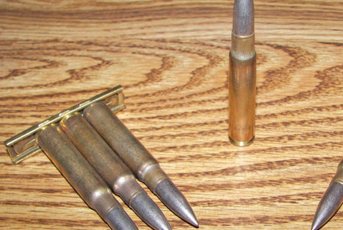Case Histories: 8x57mm Mauser
- By Pete Moore
-
0
 Comments
Comments
- Last updated: 22/11/2016

In the pantheon of great calibres the old 8x57mm/8mm Mauser lines up with the best as Wheelwrite informs us
Written about in almost every modern language, used by both sides in WWII, 108 years old and still in service today. It’s family tree goes back to 1888 with the chunky M/88 cartridge and Gewehr ‘88 service rifle, (the 1888 Commission Rifle). It has to be the 7.92 x 57mm Mauser, aka the legendary 8mm Mauser, 8 x 57 S or 8 x 57 JS.
SPITZER ‘POINTS’ THE WAY
Eager to capitalise upon the performance potential of the new smokeless propellant powders, the German Rifle Commission introduced their rimless 8mm ‘Patrone 88’ (M/88) cartridge with its massive RN 226-grain .318” pill in 1888. The evolutionary process was completed in 1905 when the Commission re-engineered the cartridge to take a newly designed, more efficient 154.3-grain .323” Spitzer bullet and 47-grains of an improved double base propellant. The all new ‘Spitz’ (German for pointed) bullet was a radical departure from the past and endowed the cartridge with an amazing speed of 2900 fps. Indeed, the design of the radical ‘S’ bullet was covered by a U.S. Patent in 1907. Following bullet retention issues in the original cartridge the early designs had an additional three point pinch crimp around the neck. In addition to gilding metal and cupro-nickel, steel was used to jacket the bullets in some production variants.
WIDESPREAD USE
Adopted by Germany in 1905 and used in a multitude of weapon designs until the 1980’s it was also employed in various rifle and machine gun applications by the military in the UK, Spain, Poland, Egypt, Israel, Yugoslavia, China, Turkey, Iran and several others. As a hunting cartridge it has found worldwide application. Almost every European rifle maker has at some time chambered a product for the cartridge – indeed; it would be easier to name those who have NOT! Not so in the USA, brief incarnations in the Model 54 Winchester and Remington 700 were all I could find. Current American cartridge makers have ‘de-tuned’ the performance to bring the pressure in line with SAAMI specifications. European products, especially eastern European brands, generally offer performance that is closer to the original.
Classic rifle enthusiasts will be familiar with the Model 98 Mauser, a collectible classic shooter for which paper punching comps exist. Country of origin and shootable condition can vary enormously. For those with deeper pockets and freezers to fill, the later models from Blaser, Mauser, Heym, Steyr and Brno will do an admirable job. As a hunting calibre it is overkill for most of our domestic game – better suited to the likes of moose and elk! Enter the hand loaded custom round, subtly detuned to suit our domestic needs, reduce costs and extend component life.
SLUG IT OR REGRET IT
If your rifle is an early military surplus model or anything other than a relatively new product you are advised to slug the barrel before investing in the reloading process. Popular data, dies and bullets are intended for use with the evolutionary .323” version. Bullet choice is limited – after all, there are only a handful of cartridges that make use of this pill diameter. Weights range from 125 to 220-grain with factory ‘duplication’ coming from the 150-grain spitzer and a compressed charge of H4350. The words of warning are worth repeating. Given the longevity of this classic cartridge and the extreme diversity of rifle condition you must measure the bore and then work up a load to suit.
